First Storey
Universal Wisdom Hall Topics
First Storey Topics
Bodhisattva Cintamanicakra Avalokitesvara
Location Description
Right behind the Hundred Dragons Hall, is the back hall of BTRTM named the Universal Wisdom Hall. Here, you will see a beautifully hand carved Tang period Bodhisattva Cintamanicakra Avalokitesvara seated upright atop an elaborate lotus throne. On the rear wall are a hand embroidery of The Heart Sutra flanked by embroideries of lotuses swaying in the breeze. Along the side walls are the eight Zodiac Protectors, each surrounded by smaller Bodhisattva Cintamanicakra Avalokitesvara statues.
All together creating a peaceful and calm atmosphere for one to reflect, pray for compassion and make wishes.
About BTRTM Bodhisattva Cintamanicakra Avalokitesvara
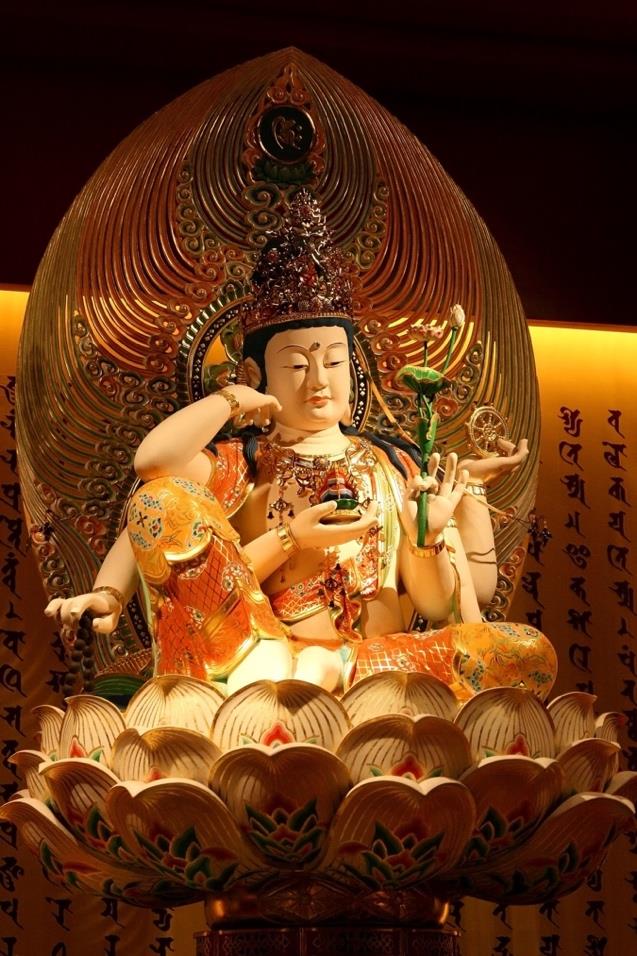
The Bodhisattva Cintamanicakra Avalokitesvara sits calmly in a typical Rajalilasana (royal ease posture), bare to the waist, atop a large Padmasana (lotus) throne floating on the sea waves, with a phoenix at each corner. The aureole is shaped like a lotus petal curved towards His head. There are colourful swirling aura and clouds radiating from His head.
The image of Bodhisattva Cintamanicakra Avalokitesvara has six hands: His first right hand touches the cheek in a pensive pose, His second right hand holding a wish granting jewel (cintamani), His third right hand holding prayer beads. His first left hand pressing the Mount Meru, His second left hand holding a lotus flower and His third left hand holding a Dharma wheel. On His head is a highly decorated chignon with an elegant gilt crown denoting the royal status.
About Bodhisattva Cintamanicakra Avalokitesvara
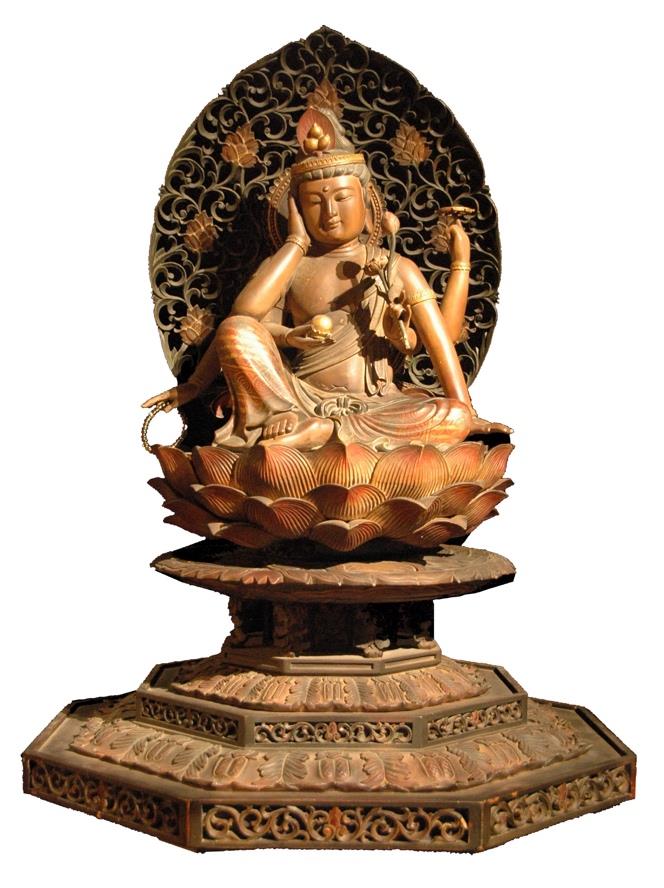
Bodhisattva Cintamanicakra Avalokitesvara (Wish-granting Jewel Wheel; Chinese: Ju-i-lun Kuan-yin; Japanese: Nyoirin Kannon) with predictable strong powers, developed over the many lives, thus achieving the Awakening called "Zheng Fa Ming Ru Lai".
In practising benevolence and saving many lives, He appears in the form of a Bodhisattva, or sometimes as the future Buddha. As He would become the Buddha after Sakyamuni Buddha leaves the Western World, He would take charge of the Western World called "Pu Kuang Gong De Shan Wang Ru Lai".
The Bodhisattva Avalokitesvara with one hand holding the Cintamanicakra pearl is known as Bodhisattva Cintamanicakra Avalokitesvara. The Cintamani pearl is able to fulfill the wishes of all living, therefore called 'Ru Yi' (meaning 'as what you wish'). Here 'Ru Yi' means Cintamani pearl, and 'wheel' means turning the Dharma Wheel. According to the Padma Cintamani Dharani Sutra, Bodhisattva Cintamanicakra Avalokitesvara, has the powers for this and future lives, to not only help all living beings achieve wealth and wisdom , but also develop the compassionate heart and avoid sufferings.
Normally, the image of Bodhisattva Cintamanicakra Avalokitesvara has six hands to rescue beings from birth in the six realms:
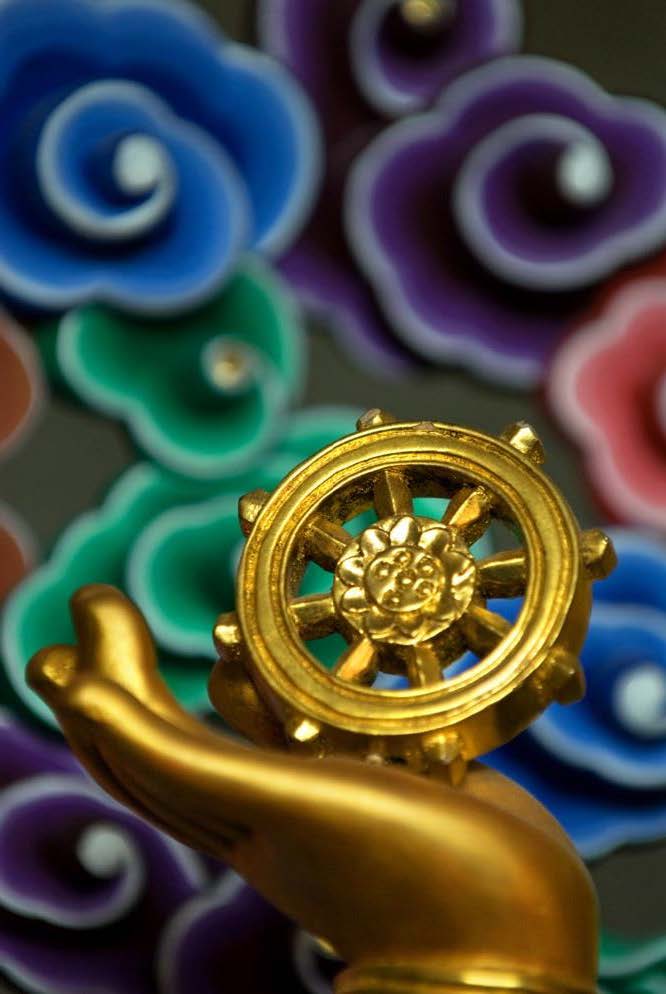
About Bodhisattva Avalokitesvara
Avalokiteśvara (Sanskrit: अवलोकितेश्वर lit. "Lord who looks down"; Chinese: Guānshìyīn Púsà, 觀世音菩薩; Tibetan: Chenrezig, སྤྱན་རས་གཟིགས་, Wylie: spyan ras gzigs; Japanese: Kannon, 観音, Kan'on, Kanzeon, 観世音; Korean: Gwan-eum, 관음, Gwanse-eum, 관세음; Thai: Kuan Eim, กวนอิม, Phra Mae Kuan Eim, พระแม่กวนอิม; Vietnamese: Quan Âm, Quán Thế Âm; Indonesian: Kwan Im, Dewi Kwan Im).
Excerpt from: Wikipedia web link https://en.wikipedia.org/wiki/Avalokiteśvara
In Sanskrit, Avalokitesvara is also referred to as Padmapāni (Holder of the Lotus), Lokeśvara (Lord of the World) and Lokanatha (Protector of the World).
Bodhisattva Avalokitesvara is a bodhisattva who embodies the compassion of all Buddhas. He is one of the most popular, most complex and most widely revered bodhisattvas in mainstream Mahayana Buddhism. He appeared early in the texts and imagery of Mahayana Buddhism in India.
The Bodhisattva Avalokitesvara is expounded by Sakyamuni Buddha in the 25th chapter of the Lotus Sutra, first translated into Chinese by Dharmaraksa in 286 AD. The belief in Bodhisattva Avalokitesvara entered China and spread rapidly after the 3rd century.
Amongst the Bodhisattvas, Bodhisattva Avalokitesvara is the most popular and venerated with the largest number of forms. This bodhisattva is variably depicted as male originally or female in China and Japan. The images may be observed as exoteric (based on Mahayana sutras - Lotus Sutra, Avatamsaka Sutra, Sukhavativyuha Sutra), esoteric (Sutra of the Eleven-headed Kuan-yin, Sutra of the Thousand-armed Kuan-yin of Great Compassion, Cundi Sutra), and sinified (Chinese texts, tales, scrolls, native stories, legends).
Bodhisattva Avalokitesvara is one of the most respected Bodhisattva in the Buddhist cosmos. Bodhisattva Avalokitesvara is a Bodhisattva who embodies the of all . He is one of the most popular, most complex and most widely revered Bodhisattvas in mainstream Mahayana Buddhism. He appeared early in the texts and imagery of Mahayana Buddhism in India.
In Tibet, Bodhisattva Avalokitesvara is associated with the Dalai Lamas and the Karmapas, who are his reincarnations.
About Birth
According to legends, he was born from a ray of light emanating from the right eye of Buddha Amitabha, causing a lotus to bloom.
Legends of Bodhisattva Avalokitesvara
One Buddhist legend from the Complete Tale of Guanyin and the Southern Seas (Chinese: 南海觀音全传; pinyin: Nánhǎi Guānyīn Quánzhuàn) presents Guanyin as vowing to never rest until she had freed all sentient beings from samsara or reincarnation. Despite strenuous effort, she realized that there were still many unhappy beings yet to be saved. After struggling to comprehend the needs of so many, her head split into eleven pieces. Amitabha Buddha, seeing her plight, gave her eleven heads with which to hear the cries of the suffering. Upon hearing these cries and comprehending them, Avalokitesvara attempted to reach out to all those who needed aid, but found that her two arms shattered into pieces. Once more, Amitabha came to her aid and appointed her a thousand arms with which to aid many. Many Himalayan versions of the tale include eight arms with which Avalokitesvara skillfully upholds the Dharma, each possessing its own particular implement, while more Chinese-specific versions give varying accounts of this number.
Another story from the Precious Scroll of Fragrant Mountain describes an incarnation of Guanyin as the daughter of a cruel king who wanted her to marry a wealthy but uncaring man. The story is usually ascribed to the research of the Buddhist monk Chiang Chih-ch'i during the 11th century CE. The story is likely to have a Taoist origin. Chiang Chih-ch'i, when he penned the work, believed that the Guanyin we know today was actually a Buddhist princess called Miaoshan (妙善), who had a religious following on Fragrant Mountain. Despite this, there are many variants of the story in Chinese mythology.
According to the story, after the king asked his daughter Miao Shan to marry the wealthy man, she told him that she would obey his command, so long as the marriage eased three misfortunes.
The king asked his daughter what were the three misfortunes that the marriage should ease. Miaoshan explained that the first misfortune the marriage should ease was the suffering people endure as they age. The second misfortune it should ease was the suffering people endure when they fall ill. The third misfortune it should ease was the suffering caused by death. If the marriage could not ease any of the above, then she would rather retire to a life of religion forever.
When her father asked who could ease all the above, Miao Shan pointed out that a doctor was able to do all of these.
Her father grew angry as he wanted her to marry a person of power and wealth, not a healer. He forced her into hard labour and reduced her food and drink but this did not cause her to yield.
Every day she begged to be able to enter a temple and become a nun instead of marrying. Her father eventually allowed her to work in the temple, but asked the monks to give her the toughest chores in order to discourage her. The monks forced Miao Shan to work all day and all night, while others slept, in order to finish her work. However, she was such a good person that the animals living around the temple began to help her with her chores. Her father, seeing this, became so frustrated that he attempted to burn down the temple. Miao Shan put out the fire with her bare hands and suffered no burns. Now struck with fear, her father ordered her to be put to death.
In one version of this legend, when she was executed, a supernatural tiger took Guanyin to one of the more hell-like realms of the dead. However, instead of being punished by demons like the other inmates, Guanyin played music and flowers blossomed around her. This completely surprised the head demon. The story says that Guanyin, by merely being in that hell, turned it into a paradise.
A variant of the legend says that Miao Shan allowed herself to die at the hand of the executioner. According to this legend, as the executioner tried to carry out her father's orders, his axe shattered into a thousand pieces. He then tried a sword which likewise shattered. He tried to shoot Miao Shan down with arrows but they all veered off.
Finally in desperation he used his hands. Miao Shan, realising the fate the executioner would meet at her father's hand should she fail to let herself die, forgave the executioner for attempting to kill her. It is said that she voluntarily took on the massive karmic guilt the executioner generated for killing her, thus leaving him guiltless. It is because of this that she descended into the Hell-like realms. While there she witnessed first-hand the suffering and horrors beings there must endure and was overwhelmed with grief. Filled with compassion, she released all the good karma she had accumulated through her many lifetimes, thus freeing many suffering souls back into Heaven and Earth. In the process that Hell-like realm became a paradise. It is said that Yanluo, King of Hell, sent her back to Earth to prevent the utter destruction of his realm, and that upon her return she appeared on Fragrant Mountain.
Another tale says that Miao Shan never died but was in fact transported by a supernatural tiger, believed to be the Deity of the Place, to Fragrant Mountain.
The Legend of Miao Shan usually ends with Miao Chuang Yen, Miao Shan's father, falling ill with jaundice. No physician was able to cure him. Then a monk appeared saying that the jaundice could be cured by making a medicine out of the arm and eye of one without anger. The monk further suggested that such a person could be found on Fragrant Mountain. When asked, Miao Shan willingly offered up her eyes and arms. Miao Chuang Yen was cured of his illness and went to the Fragrant Mountain to give thanks to the person. When he discovered that his own daughter had made the sacrifice, he begged for forgiveness. The story concludes with Miaoshan being transformed into the Thousand-Armed Guanyin, and the king, queen and her two sisters building a temple on the mountain for her. She began her journey to heaven and was about to cross over into heaven when she heard a cry of suffering from the world below. She turned around and saw the massive suffering endured by the people of the world. Filled with compassion, she returned to Earth, vowing never to leave till such time as all suffering has ended.
After her return to Earth, Guanyin was said to have stayed for a few years on the island of Mount Putuo where she practised meditation and helped the sailors and fishermen who got stranded. Guanyin is frequently worshipped as patron of sailors and fishermen due to this. She is said to frequently becalm the sea when boats are threatened with rocks. After some decades Guanyin returned to Fragrant Mountain to continue her meditation.
Dharma
According to East Asian Mahāyāna doctrines, Avalokiteśvara is the bodhisattva who has made a great vow to assist sentient beings in times of difficulty, and to postpone his own Buddhahood until he has assisted every being on Earth in achieving Nirvāṇa.
In Tibetan Buddhism, Avalokiteshvara is a fully-enlightened Buddha who appears in the aspect of a Bodhisattva disciple of Buddha Shakyamuni emphasizing the practice of great compassion. He appears in the trinity together with Manjushri and Vajrapani known as the Three Lords, representing great compassion, wisdom and spiritual power respectively.
Avalokiteshvara is also worshipped in traditional Theravadin countries such as Myanmar and Thailand.
Mahāyāna sūtras associated with Avalokiteśvara include the following:
- Saddharma Puṇḍarīka Sūtra (Lotus Sūtra)
- Kāraṇḍavyūha Sūtra
- Prajñāpāramitā Hṛdaya Sūtra (Heart Sūtra)
- Mahākaruṇā Dhāranī Sūtra (Nīlakaṇṭha Dhāraṇī)
- Avalokiteśvara Ekādaśamukha Dhāraṇī Sūtra
- Cundī Dhāraṇī Sūtra
Lotus Sutra
The Lotus Sūtra (Skt. Saddharma Puṇḍarīka Sūtra) is generally accepted to be the earliest literature teaching about the doctrines of Avalokiteśvara. These are found in the Lotus Sūtra chapter 25, The Universal Gateway of Avalokitasvara Bodhisattva (Ch. 觀世音菩薩普門品). This chapter is devoted to Avalokitasvara, describing him as a compassionate bodhisattva who hears the cries of sentient beings, and who works tirelessly to help those who call upon his name.
A total of 33 different manifestations of Avalokitasvara are described, including female manifestations, all to suit the minds of various beings. The chapter consists of both a prose and a verse section. This earliest source often circulates separately as its own sūtra, called the Avalokitasvara Sūtra (Ch. 觀世音經), and is commonly recited or chanted at Buddhist temples in East Asia.
The Buddha answered Bodhisattva Akṣayamati, saying: "O son of a virtuous family! If innumerable hundreds of thousands of myriads of koṭis of sentient beings who experience suffering hear of Bodhisattva Avalokiteśvara and wholeheartedly chant his name, Bodhisattva Avalokiteśvara will immediately perceive their voices and free them from their suffering.
O Akṣayamati! This Bodhisattva Avalokiteśvara displays such qualities, wanders through many lands in various forms, and saves sentient beings. For this reason, you should wholeheartedly pay homage to Bodhisattva Avalokiteśvara. This Bodhisattva Avalokiteśvara bestows fearlessness in times of fearful calamity. For this reason, everybody in this sahāworld calls him Abhayaṃ- dada (Giver of Fearlessness)."
Excerpt from:
The Lotus Sutra, (Taisho Volume 9, No. 262), Chapter 25;
Translated from the Chinese of Kumarajiva by Tsugunari Kubo and Akira Yuyama;
BDK Tripitaka Translation Series, Bukkyo Dendo Kyokai America, Inc;
Numata Center for Buddhist Translation and Research, 2007.
Heart Sutra
In the Chinese Mahayana canon, the Heart Sutra is ascribed entirely to the Bodhisattva Avalokiteshvara. This is unique, as most Mahayana Sutras are usually ascribed to Shakyamuni Buddha and the teachings, deeds or vows of the bodhisattvas are described by Shakyamuni Buddha. In the Heart Sutra, Avalokiteshvara describes to the Arhat Sariputra the nature of reality and the essence of the Buddhist teachings. The famous Buddhist saying "Form is empty, emptiness is form" comes from this sutra.
In most Tibetan traditions, the Heart Sutra is attributed to Buddha Shakyamuni who blessed the minds of Shariputra and Avalokiteshvara and inspired Shariputra to pose the question and Avalokiteshvara to answer. At the end of the sutra, Buddha gave His approval of the answers (which are a condensation of the Perfection of Wisdom sutras), implicitly implying that the entire sutra is in accordance with His own view.
For more information, please see 'About the Heart Sutra'.
About Great Compassion Dharani
The Mahākaruṇā Dhāraṇī (Great Compassion Dhāraṇī), also called the Nīlakaṇṭha Dhāraṇī, is an 82-syllable dhāraṇī for Avalokiteśvara.
About Cundī Dhāraṇī
"Namaḥ saptānāṃ samyaksaṃbuddha koṭīnāṃ tadyathā oṃ cale cule cundī svāhā"
Namaḥ saptānāṃ 南无飒多喃 nā mó sà duō nán
samyaksaṃbuddha 叁藐叁菩驮 sān miǎo sān pútuó
koṭīnāṃ 俱胝喃 jù zhī nán
tadyathā 怛侄他 dá zhí tuō
oṃ cale cule 唵 折隶主隶 ǎn,zhé lì zhǔ lì
cundī svāhā 准提娑婆诃 zhǔn tí suō pó hē
Mantra
"OM MANI PAD ME HUM"
唵(om)嘛(ma)呢(ni)叭(pad)咪(me)吽(hum)
Art of Bodhisattva Avalokitesvara
Bodhisattva Avalokitesvara is usually represented standing, with an effigy of Buddha Amitabha in his headdress. His is usually holding the lotus, willow branch and water or flower vase. His mount is usually a goose, peacock, phoenix or pheasant.
Bodhisattva Avalokitesvara was originally depicted as a male bodhisattva, and therefore wears chest-revealing clothing and may even sport a moustache. Although this bare-chested and moustached depiction still exists in the Far East, Guanyin is more often depicted as a woman in modern times.
Bodhisattva Avalokitesvara has an extraordinarily large number of manifestations in different forms (including wisdom goddesses (vidyaas) directly associated with him in images and texts). Some of the more commonly mentioned forms include:
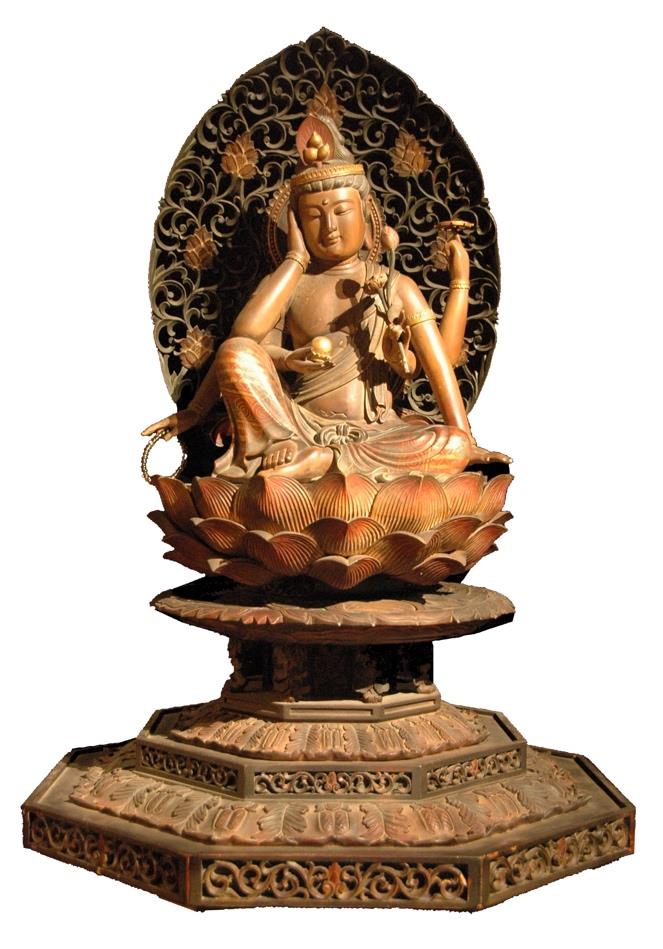
Bodhisattva Cintamanicakra Avalokitesvara, "He who holds the wheel and the wish-fulfilling jewel", sits in a royal posture. He has six arms which symbolizes His ability to help beings in each of the six Realms - hell, hungry ghosts, animals, asuras, human beings and devas.
It is found in a terracotta sealing from Nalanda in the Calcutta University. This form was represented very early in China and can be seen in the Longmen and Yungang grottoes. Also found as early as 605 in Japan.
This Cintamanichakra Avalokiteshvara (CN079) displayed at our 3rd floor Buddhist Culture Museum is crafted in the Shingon style, with one head and six arms, adorned with crown decorated with a cintamani and sits atop the lotus throne in the Rajalilasana posture, relaxed yet not losing His magnificence. On the back is the aureole of seven lotuses. Following the description recorded in the "Bodhisattva Cintamanicakra Avalokiteshvara Yoga", the first right hand makes the pensive gesture, the second holds a Ruyi jewel, the third right hand holds prayers beads, while the first left hand is seen pressing down on the bright hill, the second hand holds a lotus, while the third holds a gold chakra. The Bodhisattva is dressed in robes with beautiful motifs hand painted in colours and gold, bringing out the majestic grandeur of this sculpture.
About Mount Putuo
Mount Putuo (Chinese: 普陀山; pinyin: Pǔtúo Shān; literally "Mount Potalaka") is a small island southeast of Shanghai, in Zhoushan prefecture of Zhejiang province, China. The nearest city is Ningbo.
Mount Putuo lies on the Eastern Sea of China and displays the beauty between sea and mountain. The area is about 12.5 square kilometres and has lots of famous and sacred temples.
It is famous in Chinese Buddhism, and is considered the bodhimanda of Bodhisattva Avalokitesvara (Guan Yin).
Every year on the nineteenth day of the second, sixth and ninth lunar months, it welcomes millions of people for the celebration of the birth, ordination and enlightenment, respectively of Bodhisattva Avalokitesvara.
The Puji Monastery is the main and largest temple, with 9 halls, 13 pavilions, towers and subsidiary buildings.
Development of BTRTM Bodhisattva Cintamanicakra Avalokitesvara

The elegant Bodhisattva Cintamanicakra Avalokitesvara is modelled after a similar Tang period statue at XXX or the 兴福寺,奈良, a Buddhist temple in the city of Nara, Nara Prefecture, Japan.
A small wood model (right) was commissioned from China Chin Ting Enterprise Co Ltd, Fuzhou, China which arrived in March 2006. This was displayed in our ex-showroom office at 293 South Bridge Road for evaluation and public feedback. It is presently displayed on the 3rd floor Buddhist Culture Museum.

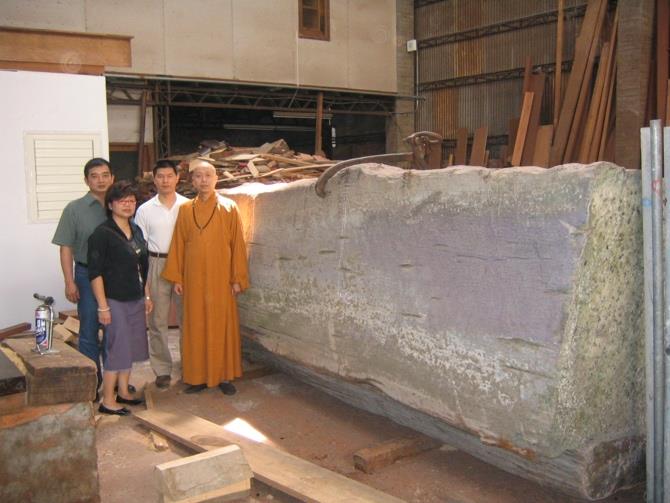
The statue of the Bodhisattva Cintamanicakra Avalokitesvara, venerated in the Universal Wisdom Hall, was carved from the same hinoki log as the Maitreya Buddha by the renowned Taiwanese master carver Mr Chen Mingfeng of Huangmu Art Center at Miao Li, Taiwan.
A polystyrene full-scale model was made to ascertain the desired characteristics before carving commenced. Venerable Chao Khun Fa Zhao inspected and fine- tuned the polystyrene model in early November 2005.
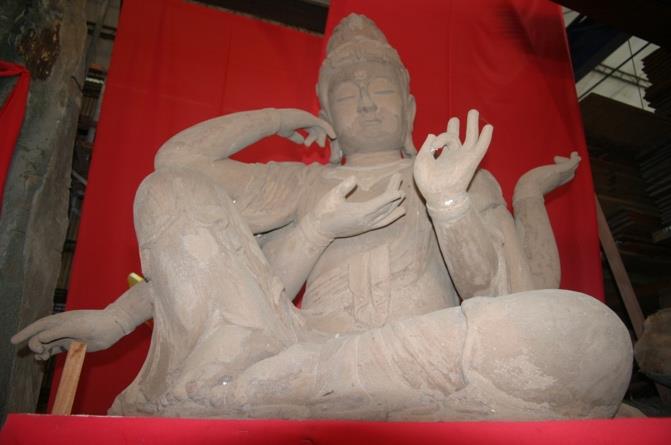
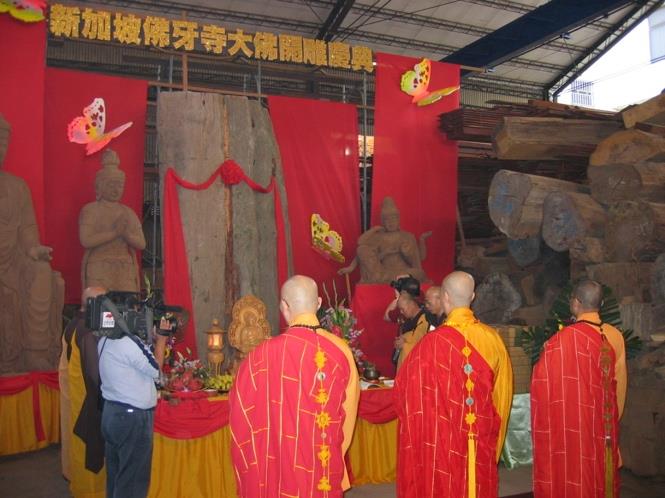
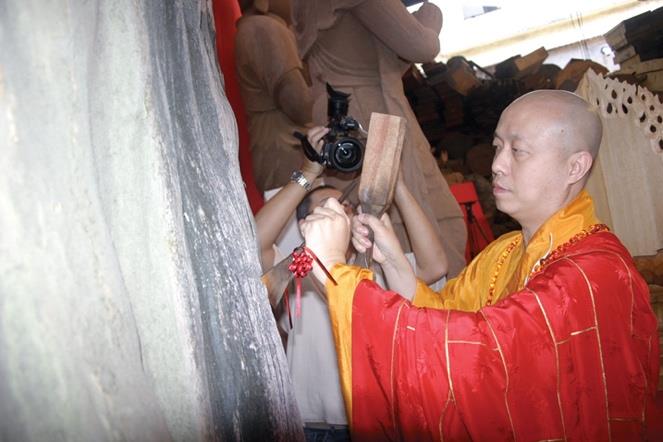
A blessing ceremony for the commencement of wood carving was held on 7 November 2005, led by Venerable Chao Khun Fa Zhao with the Sangha from Taiwan and devotees from Singapore.
After which, the careful and rigorous carving by Mr Chen Mingfeng and his team started in earnest. Venerable Chao Khun Fa Zhao made several trips to monitor the progress and fine tune the work. By 27 March 2006, the main features of the carving were completed.
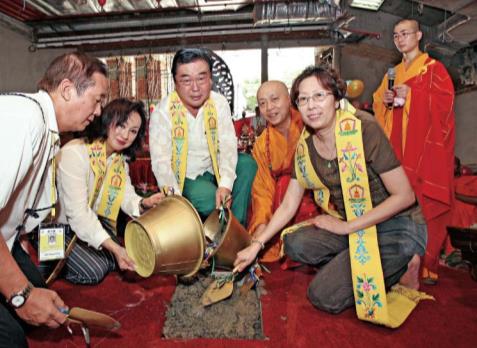
The Bodhisattva Cintamanicakra Avalokitesvara Sumeru Vault ceremony was held on 26 September 2006 to prepare the altar for receiving the Bodhisattva Cintamanicakra Avalokitesvara statue. The altar was cladded in special lacquered panels, transformed into a phoenix throne by the Chin Ting Enterprise Co Ltd in Fuzhou, China. You will notice many Tang style phoenixes around the base of this altar.
The fully completed Bodhisattva Cintamanicakra Avalokitesvara statue was shipped to Singapore in November 2006.
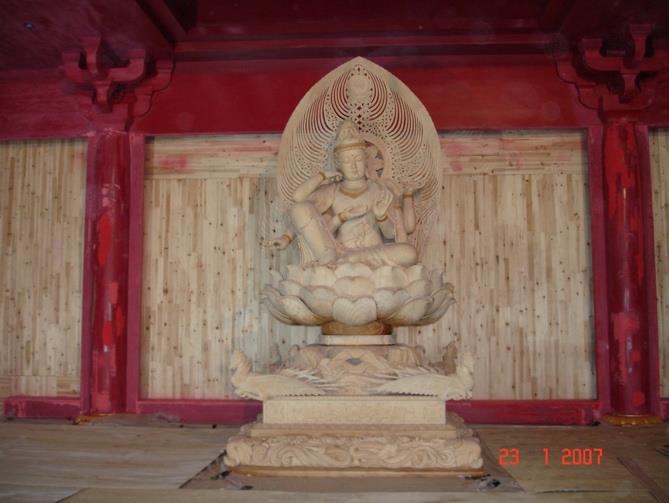
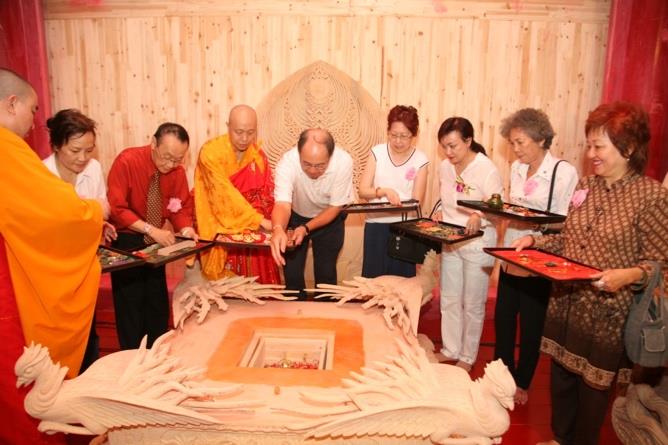
On 21 January 2007, the Bodhisattva Cintamanicakra Avalokitesvara Throne Sealing ceremony was held.
The team from Shanghai You Shan Guan Decorative Design Co Ltd, led by Mr Zhang Jian undertook the painstaking painting of the Bodhisattva Cintamanicakra Avalokitesvara, the lotus throne and the aureole.
The base coat was applied in January 2007.
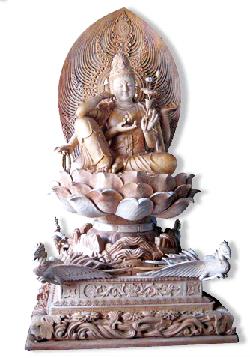

Later, the team added colours using grounded natural stones and vegetable dyes, as well as gold leaf.
By Chinese New Year 2007, this was partially coloured.
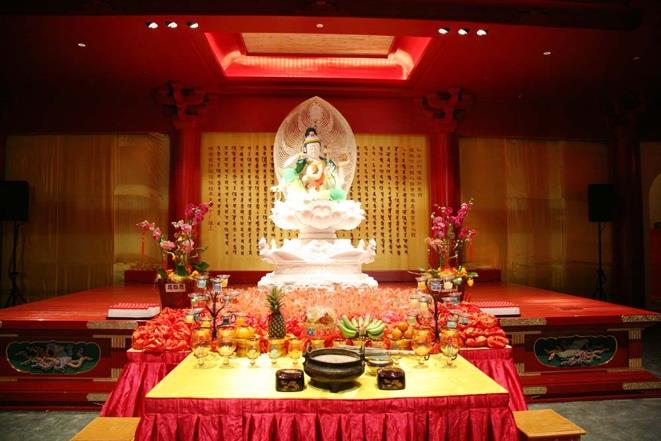
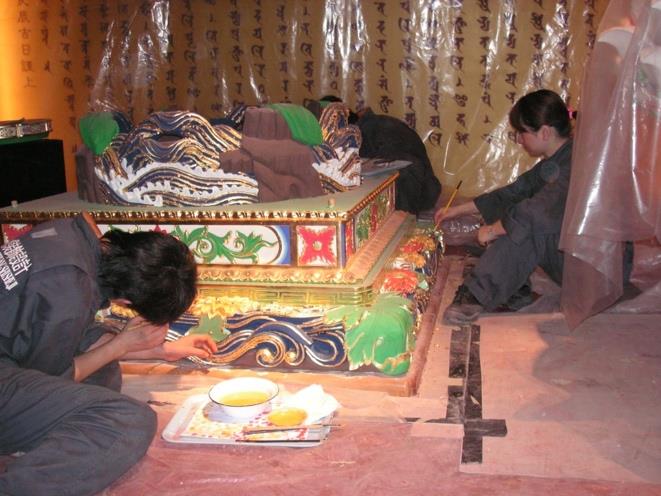
After the Chinese New Year, work resumed to complete the painting works.
In April 2007, the Bodhisattva Cintamanicakra Avalokitesvara was finally hoisted into place.
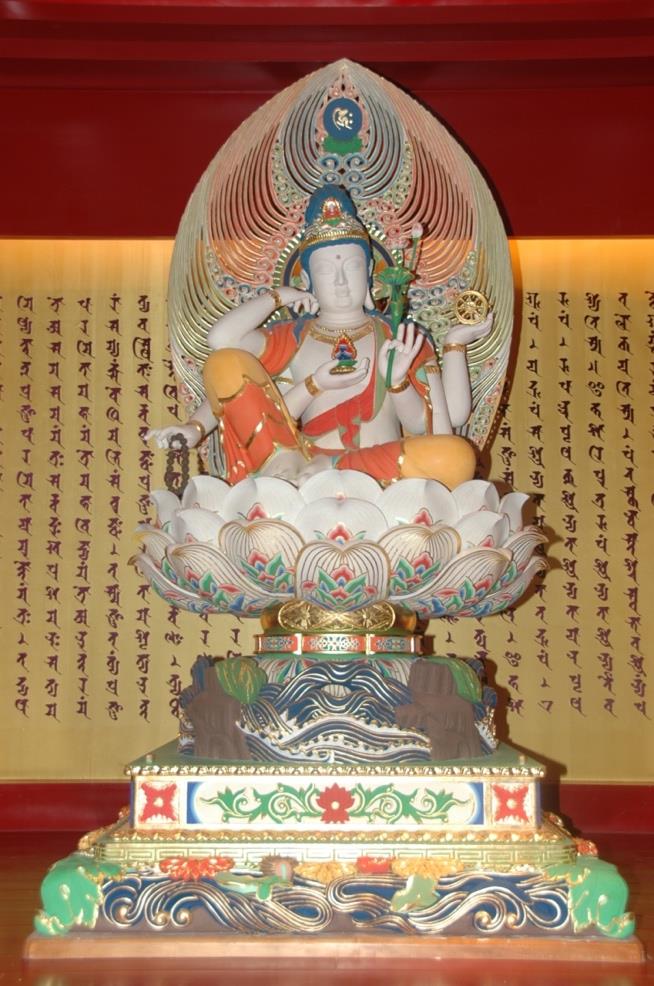
From 1 to 7 May 2007, 12 monks from XXX Monastery, Thailand conducted a 24hours by 7-days, purification and blessing ceremony. This was followed by the final laying of the gold trimmings and final paint touch-ups.

The Bodhisattva Cintamanicakra Avalokitesvara was consecrated by Most Venerable XXX during the BTRTM Grand Consecration Ceremony on 17 May 2008.
The Bodhisattva Cintamanicakra Avalokitesvara image placed in the Universal Wisdom Hall is dedicated to world peace, compassion, fulfillment of wishes and transference of merits to all sentient beings for good health, peace, prosperity and be reborn in the Amitabha Pureland for guidance towards enlightenment.
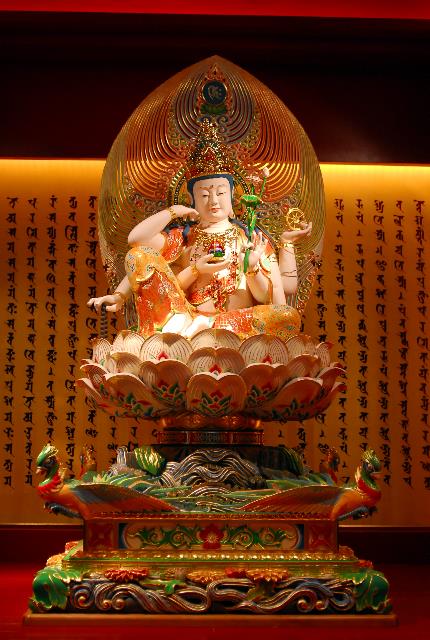
Bodhisattva Avalokitesvara Celebrations at BTRTM
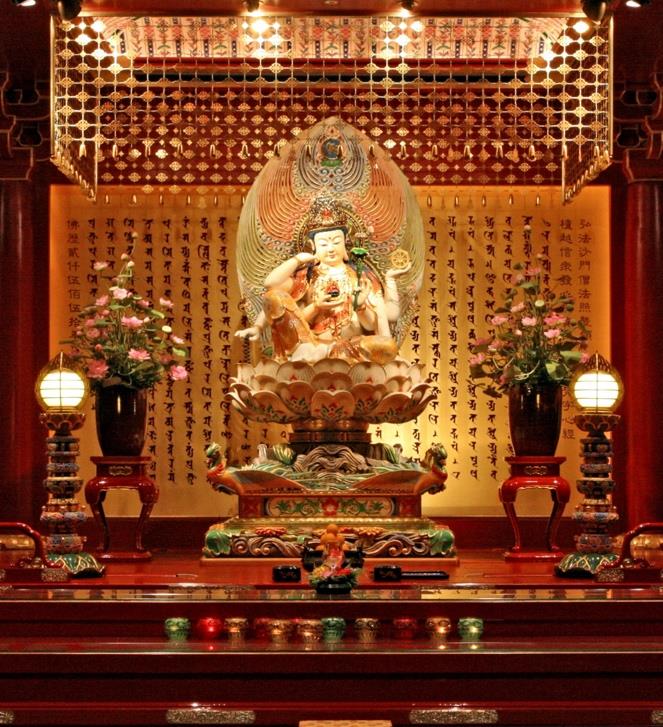
In China, his festive dates are the nineteenth day of the second lunar month (Birth), sixth lunar month (Ordination) and ninth lunar month (Enlightenment).
Pilgrimage Site
Mount Putuo in China is the pilgrimage site.
Merits of Donation
The Buddha said: "If there is anyone who holds to the name of Bodhisattva Avalokiteśvara and anyone who pays homage to him and makes offerings even for a moment, the merit of these two people will be equal and the same; it will never be extinguished after hundreds of thousands of myriads of koṭis of kalpas.
O Akṣayamati! Those who hold to the name of Bodhisattva Avalokiteśvara will attain such benefits of immeasurable and limitless merit."
Excerpt from:
The Lotus Sutra, (Taisho Volume 9, No. 262), Chapter 25;
Translated from the Chinese of Kumarajiva by Tsugunari Kubo and Akira Yuyama;
BDK Tripitaka Translation Series, Bukkyo Dendo Kyokai America, Inc;
Numata Center for Buddhist Translation and Research, 2007.
Thank You
May you and your loved ones be blessed with the numerous merits.
Media Links:
Bibliography:
The Threefold Lotus Sutra, translated by Bunno Kato, Kosei Publishing Co, 1975, ISBN 4-333-00208-7
John Blofeld, Bodhisattva of Compassion, The Mystical Tradition of Kuan Yin, Shambala Dragon Editions, 1977, ISBN 0-87773-126-8
Lokesh Chandra, Dictionary of Buddhist Iconography, International Academy of Indian Culture and Aditya Prakashan, 1999, Vol 3, pages 808 - 830
Louis Frederic, Buddhism, Flammarion Iconographic Guides, 1995, ISBN 2-08013-558-9, pages 153 - 180
Meher McArthur, Reading Buddhist Art, An Illustrated Guide to Buddhist Signs & Symbols, Thames & Hudson,2002, pages 43 - 45
Yu Min Lee, Visions of Compassion: Images of Kuan-yin in Chinese Art, National Palace Museum Taipeh, 2000, ISBN 957-562-388-6
Ling Haicheng, Buddhism In China, translated by Jin Shaoqing, China Intercontinental Press, pages 68 -73
Famous Chinese Mountains - Sacred Buddhist Lands, 1996, Hong Kong tourism Press, ISBN 062-7799-39-4, pages 20 - 33
Fan Jinshi, Peng Jinzhang, A Study of the Textual Presentations of the Avalokitesvara Cintamanicakra Sutra, Buddhism and Buddhist Art of the Tang, edited by Ku Cheng Mei, Chue Feng, 2006, ISBN 957-98434-8-1, pages 131 - 150,
Nandana Chutiwongs, Visualizing Avalokitesvara in 7th to 9th Century South and Southeast Asia, Buddhism and Buddhist Art of the Tang, edited by Ku Cheng Mei, Chue Feng, 2006, ISBN 957-98434-8-1, pages 167 - 182
Geshe Sonam Rinchen, The Heart Sutra: An Oral Teaching, Snow Lion Publications, 2003.



